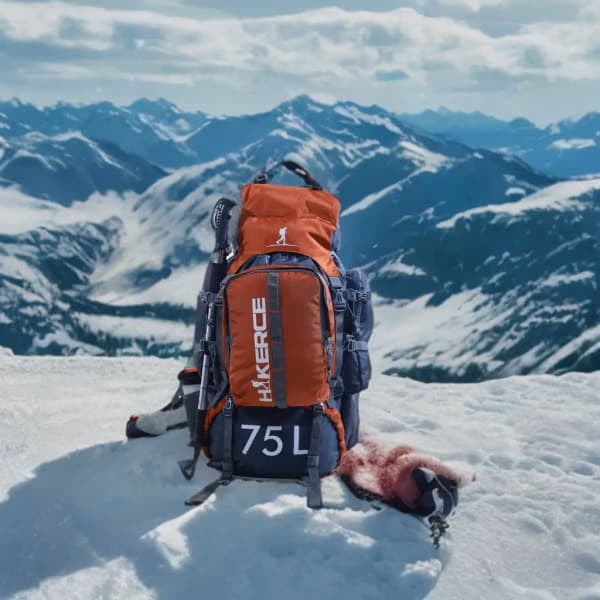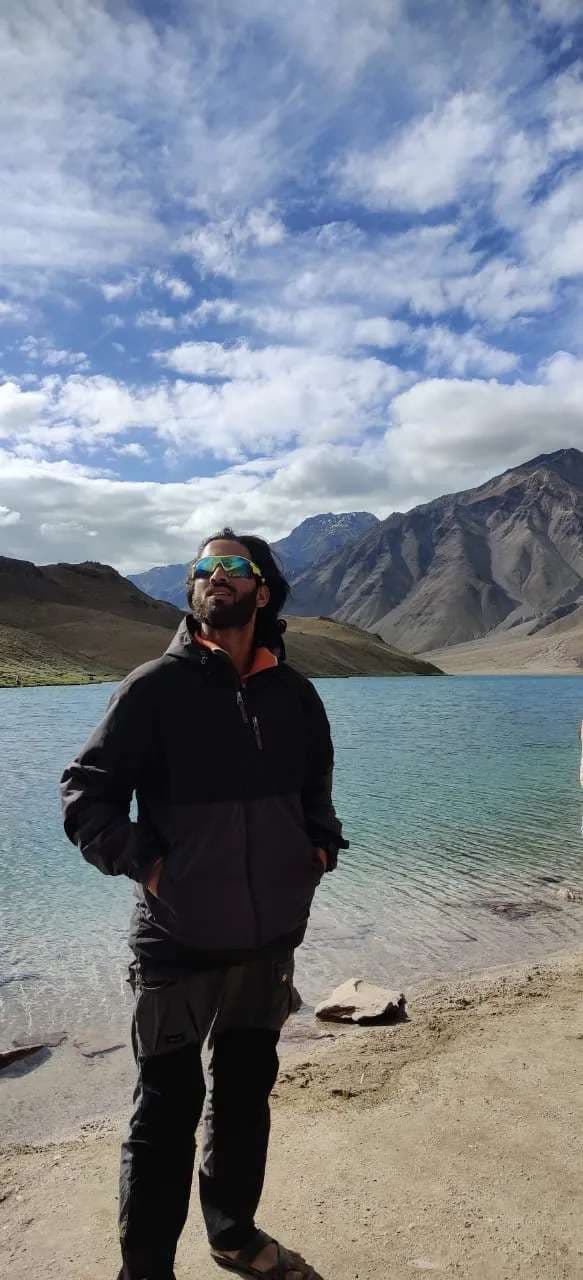Hampta Valley snow trek, nestled in the Himalayan state of Himachal Pradesh, India, is a spellbinding adventure that leads you through a winter wonderland of pristine beauty. This trek is renowned for its breathtaking landscapes, including snow-clad mountains, dense pine forests, and frozen rivers. Starting from the picturesque town of Manali, the trek takes you on a journey that typically spans around 4 days, leading you to an altitude of 3,079 meters (10,104 feet) at the Hampta Pass. Along the way, you'll cross over icy streams, camp beneath starry Himalayan skies, and bask in the solitude of the snowy wilderness. The Hampta Valley trek offers a thrilling challenge, making it a favorite among adventure seekers, photographers, and nature enthusiasts looking to embrace the serene, snow-covered beauty of the Himalayas during the winter months.
Trekking through Hampta Valley in Himachal Pradesh promises an unforgettable journey into the heart of the Himalayas. This scenic trail leads you through a landscape that transforms dramatically with the seasons. During the summer months, lush green meadows and vibrant wildflowers paint the valley, creating a picturesque setting. As you ascend, the views of snow-clad peaks become increasingly breathtaking. The trek culminates at Hampta Pass, where you'll be surrounded by towering mountains. Along the way, you'll cross gushing streams, traverse dense pine forests, and visit remote villages, offering opportunities to immerse in local culture. The allure of Hampta Valley lies in its accessibility and versatility, making it suitable for both beginners and experienced trekkers. Whether you seek the lushness of summer or the tranquility of winter's snowy wonderland, Hampta Valley delivers a stunning Himalayan experience year-round.
Best time to do Hampta Valley Snow Trek
The best time to undertake the Hampta Valley snow trek in Himachal Pradesh, India, is during the winter months, which typically span from late November to March. This period offers the most enchanting and authntic snow trekking experience. Here are some details about why this time is ideal:
Snow-Covered Landscapes: The main attraction of the Hampta Valley snow trek is the opportunity to walk through snow-covered landscapes. The entire region transforms into a winter wonderland, with pristine white snow, frozen rivers, and ice formations that create a magical atmosphere.
Serene and Quiet: Winter is considered the off-season for trekking in the Himalayas, which means fewer crowds and a more peaceful experience. The solitude and tranquility of the snow-covered wilderness are part of the trek's allure.
Photography Opportunities: The snow-capped scenery and clear winter skies provide stunning opportunities for photography. The stark contrast between the white snow and the blue sky, along with the majestic mountain views, makes for breathtaking shots.
Adventure and Challenge: Winter trekking in the Himalayas adds an element of adventure and challenge due to the cold weather and slippery terrain. It's a thrilling experience for those seeking an adrenaline rush and a sense of accomplishment.
Difficulty level of Hampta Valley Snow trek
The difficulty level of the Hampta Valley snow trek can vary depending on the time of year, weather conditions, and individual trekking experience. Since you're interested in providing information for your website trekyaari.com, I'll provide insights into the general difficulty level of the Hampta Valley snow trek.
1. Seasonal Variation: The Hampta Valley trek can be done during two main seasons: summer (June to September) and winter (December to February). The difficulty level differs significantly between these two seasons. - Summer: During the summer months, the trek is considered moderately challenging. The weather is generally pleasant, and the trail is free of snow, making it more accessible. However, there may be occasional rain, which can make the path slippery. - Winter: The winter trek to Hampta Valley is notably more challenging. The entire region is covered in snow, adding to the difficulty. Trekkers should be well-prepared with appropriate gear, including warm clothing, snow boots, and trekking poles. The trail can be steep and icy in places, demanding careful navigation and experience in snow trekking.
2. Altitude Gain: The trek starts from Manali and gradually ascends into the Hampta Valley. The maximum altitude reached on this trek is relatively lower compared to some other Himalayan treks, usually around 10,000 to 12,000 feet (3,048 to 3,658 meters). Altitude sickness is less of a concern compared to higher-altitude treks, but it's still essential to be aware of its symptoms.
3. Duration: The Hampta Valley snow trek typically takes around 4 to 5 days to complete, depending on the chosen itinerary. The duration can affect the overall difficulty, as longer treks may require better endurance and stamina.
4. Terrain: The terrain varies from snow-covered meadows to rocky paths, especially during the winter. Trekkers should be prepared for a mix of terrain and changing conditions.
5. Fitness Level: For the winter trek, it's advisable to have a good level of fitness and some prior trekking experience, especially in snowy conditions. Regular cardio and strength training can help prepare your body for the physical demands of the trek.
6. Guided vs. Independent: Many trekkers opt for guided tours during the winter trek, as they provide a level of support and guidance in challenging conditions. Going independently can be more demanding, as you'll need to manage logistics and safety measures yourself.
In summary, the Hampta Valley snow trek can range from moderately challenging in the summer to considerably challenging in the winter. Your choice of season and level of preparedness will significantly influence the trek's difficulty. It's crucial to assess your abilities, prepare adequately for the conditions, and be aware of potential challenges before embarking on this trek. You can create informative blog content on trekyaari.com that covers the specifics of both summer and winter treks in Hampta Valley, including the varying difficulty levels and preparation tips for each season.
Things to carry for Hampta Valley Snow Trek
If you are planning on embarking on the Hampta Valley Snow trek, it is essential to have the right gear and equipment to ensure a safe and comfortable journey. Here is a list of items you should consider bringing:
Back Pack (45 L to 55 L)
Warm Clothes (4-5 layers)
4-5 pairs of socks
1 Pair Gloves
1 Warm Jacket
1 Pair Warm Cap
Hiking Shoes
Raincoat or Poncho
Toilet Papers
Water Bottle (Thermal water for snow trek)
Snacks like dry fruits, energy bar, candies etc.
Power bank / Charger
Sunscreen / Lip guard / Moisturizer
Torch
One Valid ID Proof
Tiffin Box
How to Prepare for Hampta Valley Snow trek
Preparing for a Hampta Valley snow trek requires careful planning and the right gear due to the challenging winter conditions. Since you're interested in providing detailed blog content for your website trekyaari.com, here's a comprehensive guide on how to prepare for a Hampta Valley snow trek:
1. Choose the Right Season: Decide whether you want to undertake the Hampta Valley trek during the winter season (December to February) when it's covered in snow. Be aware that winter treks are more challenging and require additional preparation.
2. Physical Fitness: Start a fitness routine well in advance. Focus on cardiovascular exercises, strength training, and endurance to prepare your body for the physical demands of trekking in the snow.
3. Acclimatization: Spend a day or two in Manali or a nearby location to acclimatize to the altitude before beginning the trek. This helps reduce the risk of altitude sickness.
4. Gear and Clothing: Invest in high-quality cold-weather gear, including: - Warm, insulated clothing (layers are key) - Waterproof and insulated boots - Gaiters to keep snow out of your boots - Thermal socks and gloves - Snow goggles and sunglasses - Down or synthetic insulated jacket - A good-quality sleeping bag rated for cold temperatures
5. Trekking Equipment: Carry essential trekking equipment such as trekking poles, a sturdy backpack, a headlamp, and a multi-tool kit.
6. Proper Documentation: Ensure you have all necessary permits and identification for the trek. Check local regulations and obtain any required permissions.
7. Food and Water: Plan your meals and carry enough high-energy snacks like nuts, chocolates, and dried fruits. Carry a reusable water bottle and purification tablets or a filter for safe drinking water.
8. Navigation and Maps: Familiarize yourself with the trek route and carry detailed maps or a GPS device. The trail can be covered in snow, making it easy to lose your way.
9. Emergency Kit: Pack a basic first aid kit, including medications you may need. Carry a whistle, emergency blanket, and a fully charged mobile phone with a power bank.
10. Guided vs. Independent Trek: Decide whether you want to trek independently or with a guided group. Guided treks often provide additional safety and support in winter conditions.
11. Weather Forecast: Check the weather forecast for Manali and the Hampta Valley before and during your trek. Be prepared for sudden weather changes.
12. Leave No Trace: Follow Leave No Trace principles to minimize your impact on the environment. Pack out all trash and maintain the pristine beauty of the region.
13. Training and Practice: If you're new to snow trekking, consider taking a short training course to learn basic snow and ice techniques, such as walking with crampons and using an ice axe.
14. Communication: Inform someone reliable about your trekking plans, itinerary, and expected return date. Check in with them regularly if possible.
15. Group Dynamics: If you're trekking in a group, establish good communication and teamwork. Stick together and look out for each other in challenging conditions. Remember that winter treks in the Himalayas, including the Hampta Valley trek, can be physically demanding and require careful preparation. It's essential to prioritize safety and be well-equipped to enjoy the stunning snow-covered landscapes and unique experiences that this trek offers.
Safety considerations during the Hampta Valley Snow Trek
Safety is paramount during the Hampta Valley Snow trek, especially given the challenging terrain and weather conditions. Here are some essential safety considerations:
1. Weather Awareness: Stay updated on the weather forecast before and during the trek. Sudden snowstorms and temperature drops are common in high-altitude areas.
2. Acclimatization: Acclimatize properly to the high altitude to avoid altitude sickness. Spend a day in Manali or a nearby location before starting the trek.
3. Proper Gear: Ensure you have the right gear, including warm clothing, waterproof layers, insulated boots, gloves, and sunglasses. Dress in layers to regulate body temperature.
4. Emergency Contacts: Carry a list of emergency contacts, including local authorities, trek organizers, and nearby medical facilities.
5. Guide and Group: It's advisable to trek with an experienced guide and in a group. They can provide navigation, first aid, and assistance in case of emergencies.
6. Communication: Carry a fully charged mobile phone with a power bank and have a satellite phone or emergency communication device as a backup.
7. Emergency Shelter: Be prepared with emergency shelter options like tents or a bivouac sack in case you get caught in a snowstorm or need to spend an unplanned night.
8. Navigation: Familiarize yourself with the route and carry a map, compass, or GPS device. Whiteouts and snow-covered trails can make navigation challenging.
9. Avalanche Awareness: Learn about avalanche safety and terrain evaluation. Avoid slopes with avalanche danger and know how to use avalanche safety gear like transceivers, probes, and shovels. 10. Hydration and Nutrition: Stay hydrated and carry sufficient food. Cold weather can lead to increased fluid loss, and adequate nutrition is essential for energy. 11. Snow Bridge Safety: Exercise caution when crossing snow bridges or frozen water bodies. Test the strength of the ice and snow before proceeding.
12. Leave No Trace: Follow Leave No Trace principles to minimize your impact on the environment. Dispose of waste responsibly.
13. Emergency Plan: Have an emergency plan in place, including a rendezvous point and communication protocol in case you get separated from your group.
14. Insurance: Ensure you have trekking and medical insurance that covers high-altitude trekking and potential evacuation costs.
15. Local Knowledge: Listen to local guides and residents. They have valuable knowledge about the terrain, weather, and safety precautions.
16. Self-Care: Pay attention to your physical and mental well-being. If you experience symptoms of altitude sickness or cold-related illnesses, communicate them to your group and guide. Remember that trekking in snowy conditions adds an extra layer of complexity and risk. Prioritize safety at all times and be prepared for changing weather conditions.


















































